Personnel Index - Detail
Awarded the DFC (27th March 1945).
Sgt J S McDonald flew 22 operations with 49Sqn before transferring to Pathfinders with 83 Squadron.
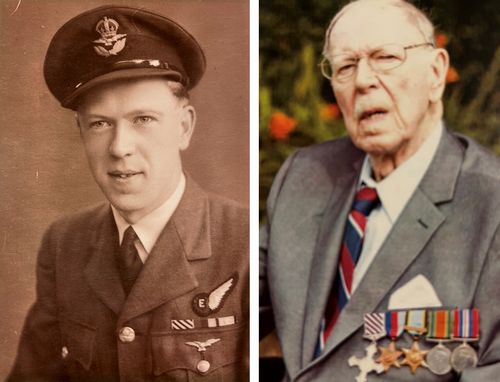
P/O John MacDonald photographed in 1945 (with Pathfinder badge) and in 2018.
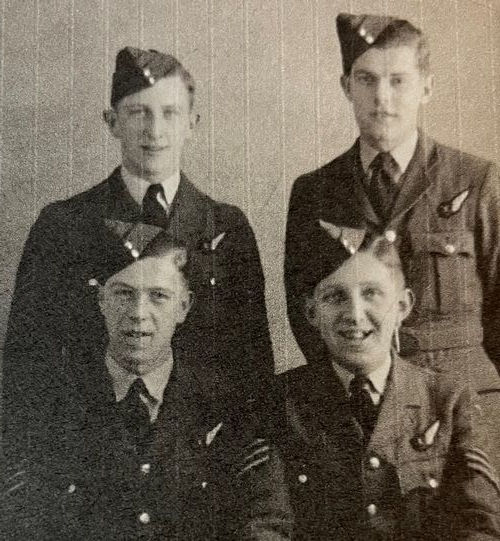
Sgt MacDonald (with colleagues) is bottom left.
His first two operations were flown with P/O JJ Lett.
During the second of these, to Berlin on the 24th March 1944, they were hit by incendiaries falling from aircraft flying above them and this caused a fire around the port inner engine.
Later in the flight, the outer port engine caught fire but it went out on its own.
Sgt MacDonald's logbook entry records, “Port engines feathered due to fires and returned to base on two starboard engines”.
P/O Lett’s logbook documents, “Fire on port side”.

The above is an extract from "Beware of The Dog at War" - our squadron history.
For the majority of operations with 49Sqn the crew were:
Pilot: F/Lt. P C Cornish, DFC and BAR - Pete, Australian
F/Engineer: F/O J S MacDonald, DFC - Mac, Renfrew
Navigator: S/Ldr W H Westphal, DFC - Bob, Australian
Nav/B: F/Lt W D Kenny, DFC - Dav, Australian
W/OP: W/O K G Wall, DFM - Ken, Birmingham
M/Gunner: F/Lt N F Cole, BEM - Nobby, London
R/Gunner: F/S A Maunder, DFM - Al, Manchester
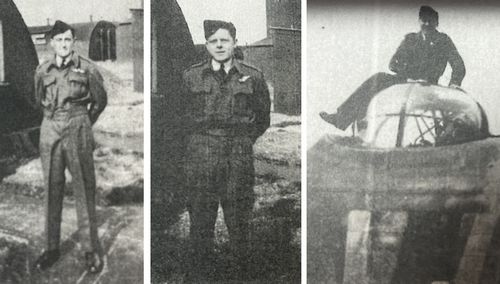
From L to R: F/Lt Cornish, S/Ldr Westphal, Sgt Maunder,
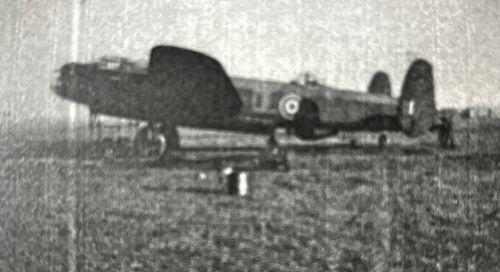
This Lancaster is 'L-Love' of 83Sqn.....note the H2S dome.
It would appear that, after the war, the crew were able to visit Berlin (at ground level).
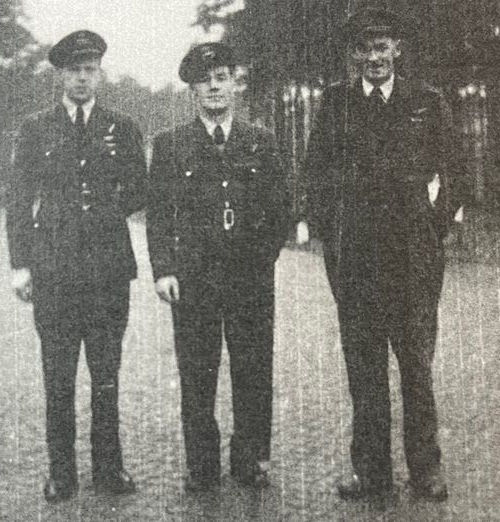
P/O MacDonald, Unknown Officer and F/L Cornish
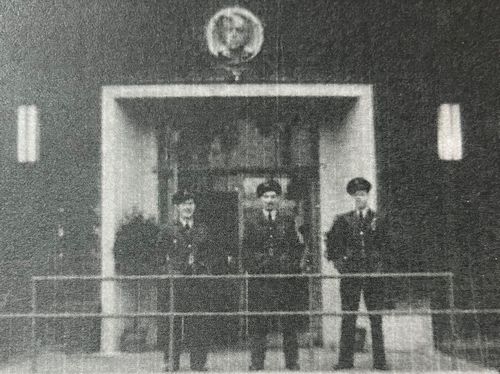
Unknown aircrew with P/O MacDonald (RHS)
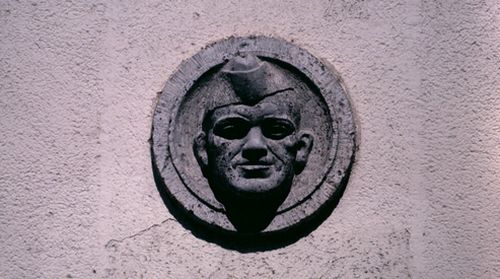
We believe that the Berlin images were taken at Gatow airfield.
The above image shows a similar feature photographed by the Webmaster above the doorway of a Mess building at RAF Gatow.
Additional details, courtesy of his son, Gavin MacDonald:
My father, John S MacDonald was born March 18th, 1924, in Renfrew, Scotland. His first job after leaving school was with Northern and Scottish Airways (Renfrew Aerodrome) in the maintenance crew where he repaired the fabric on aircraft wings.
In 1942, when he turned 18 he enlisted in the Royal Air Force Volunteer Reserve. Completing the training (at RAF St. Anthan) to become a flight engineer he was promoted to the rank of sergeant and was awarded Flight Engineer’s wings on graduation.
John's first aircraft was the Short Stirling bomber with 1661 Heavy Conversion Unit (HCU) followed later by the Lancaster (Mk I and III) with 49 Squadron.
With Scottish Airways, he volunteered for the air ambulance service contracted by HIMS, the Highlands and Islands Medical Service.
His position as operations officer involved organizing aircraft and crew call-outs, and it was on such an operation that he cheated death once more.
On September 28th, 1958 he arranged for an air ambulance and crew to fly to the island of Islay and pick up a patient.
He would usually accompany the crew, but that evening he was in bed with bad flu (his wife, Vera, told him not to go because he had a high fever).
That flight crashed on the hillside above Islay airport with the loss of the pilot, radio officer and nurse who were all friends of my father.
Interestingly he kept records of all his air ambulance flights in his war log book along with crew, aircraft type and destinations.
Amongst the aircraft were Airspeed (AS 10) Oxfords, DC3 (Dakota), and Vickers VC.1 Viking.
He enjoyed his last few years at Erskine Home because his room was next to a Spitfire Pilot and across from a Hurricane Pilot along with many other war time heroes, all with their own war stories.
I would have enjoyed sitting at their meal tables listening to their stories from the WWII days.
The catalyst for reaching out to 49Sqn was my own 90 min flight on Lancaster VeRA at the Canadian Warplane Heritage Museum in Hamilton, Canada.
My flight was on 25th August this year and it was both an honour and thrill to fly in a Lancaster.
Granted my flight was in the daytime and in friendly skies........not at night through flak and being attacked by enemy aircraft (my father cites ME109s and JU88s). As you can imagine I had proud thoughts of my father that day.
What an incredible flight it was. I was very surprised on how smooth and vibration free the flight was. We flew over to Toronto and circled the CN Tower at 1800ft, the same height as the tower and then over to Niagara Falls.
I was expecting it to be a noisy vibrating aircraft. I have flown in worst 'bone rattling' aircraft on commercial flights. We had to wear ear muffs as the roar of the four Merlins was incredible on take off. The raw power was thrilling. I guess my father maintained his hearing due wearing headphones?
I still don’t know how he got over the double wing spar you have to climb over to get front and back.
It was easy for me as I wore jeans and t-shirt that day. But with fur lined boots and jackets?

Me, holding a copy of my father’s logbook and photo on the flight.
Pilot John McClenaghan, retired Canadian Airforce pilot (right) and copilot Dave Rohrer, museum CEO and retired Canadian Airline 767 pilot (left).
Four passengers with me (3rd from right) and Paul, (my good friend, 4th from the right)
Posted out: April 2018.
